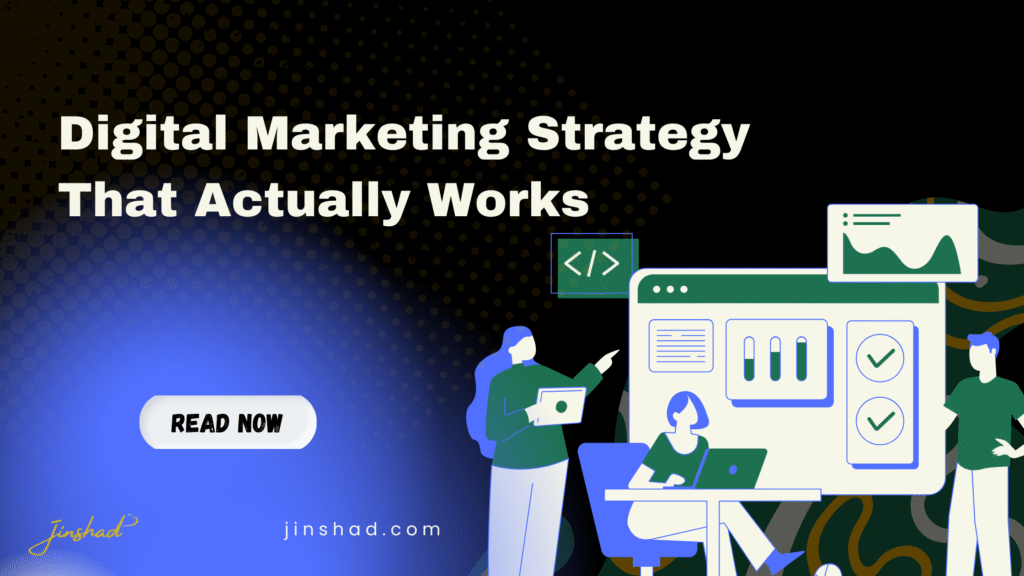Digital Marketing Strategy
In a digital world filled with advertisements, content, and constant competition, having a strong digital marketing strategy is not only useful, but also required. Without a clear direction, firms can go from tool to tool and trend to trend. This manual lays out a detailed, implementable plan to help you acquire leads, establish your reputation, and reach
“New to digital marketing? Check out our beginner’s guide.”
Step 1: Set Specific, Measurable Objectives
Know your aims before using any strategies.
Increased traffic to the website?
More sales or leads?
More social media engagement?
Improved search engine rankings?
Better search engine rankings? tangible development in 2025.
Step 2: Understand Your Audience.
A successful approach begins with identifying who you’re targeting:
Demographics (age, location, and gender)
- Behavior (search habits, purchasing cycle)
- Interests and Pain Points
🛠️ Recommended tools:
- Google Analytics.
- Meta (Facebook) Audience Insights
Customer surveys or interviews.
Step 3: Build a Strong SEO Foundation.
SEO is a long-term asset that generates free, focused visitors.
“Search Engine Optimization (SEO) is a crucial part of digital marketing. Learn more about why SEO still matters in 2025.”
On-page SEO:
- Optimize your titles, meta descriptions, headers, and images.
- Use relevant keywords naturally in your article.
- Internal Linking Structure
Technical SEO:
- Mobile-friendly website.
- Quick loading speed
- SSL Security (HTTPS)
- Proper XML sitemap and robots.txt
For local SEO:
- consider optimizing Google Business Profiles.
- Local citations
- Local landing pages.
Step 4: Use Social Media Strategically.
You don’t have to be on every platform; only the proper ones.
Goals:
- Create brand awareness.
- Engage with your audience.
- Drive traffic to your website.
Platform examples:
- Instagram for visual brands.
- LinkedIn for B2B.
- Facebook provides community-focused content.
- YouTube provides evergreen video content.
Use a content calendar, and mix:
- Educational posts.
- Testimonials
- Behind-the-scenes
- Promotions and Offers
Step 5: Launch Targeted Paid Ads (PPC).
Paid advertising get rapid visibility. Use them in conjunction with SEO to achieve short-term results.
Google ads:
- Run Search Ads for High-intent Keywords
- Use display and remarketing to re-engage visitors
Social media ads:
- Facebook and Instagram can boost B2C awareness and conversions.
- LinkedIn ads for professional targeting.
Using GA4 or ad platform dashboards, you may track metrics such as CTR, CPC, ROAS, and conversion.
✉️ Step 6: Nurture Leads Through Email Marketing
Email is one of the highest-returning channels.
Strategy:
- Utilize lead magnets (free guides, coupons, etc.).
- Segment subscribers (new vs. returning, interests).
- Automate sequences for welcome, nurture, abandoned cart, and re-engagement.
Tip:
- Conduct A/B tests on subject lines.
- Keep your emails mobile-friendly.
- Always have a clear CTA.
Step 7: Generate High-Value Content
Great content attracts, educates, and converts your target audience.
Content types:
- Blog posts.
- Case Studies
- Videos
- Infographics
- Webinars
Concentrate on themes that your audience looks for. Use tools such as
- AnswerThePublic.
- SEMrush
- Google Trends
Step 8: Ensure Consistent Branding.
Your brand should be recognizable and trustworthy across all channels.
- Consistent color palette, logo, and fonts.
- Clear message and brand tone
- Visual storytelling that reflects values
Step 9: Measure, Analyze, and Optimize.
The optimal strategy is data-driven and constantly improving.
- Google Analytics 4: tracks user behavior and traffic sources.
- Google Search Console: Search Visibility
- Social media insights: engagement and reach.
- CRM/email reports: openings, clicks, and conversions
Optimize:
- doubling down on what works.
- Drop or fix what doesn’t.
- Conduct monthly performance reviews.
Conclusion
A successful digital marketing approach is not one-size-fits-all. It’s a well-balanced, ever-changing ecosystem that brings together SEO, content, social media, PPC, email, branding, and data analytics to achieve one common goal: growth.
Whether you’re a freelancer, a small business owner, or an agency, creating and consistently updating this framework is the key to achieving genuine, long-term outcomes in 2025.
“New to digital marketing? Check out our beginner’s guide.”
